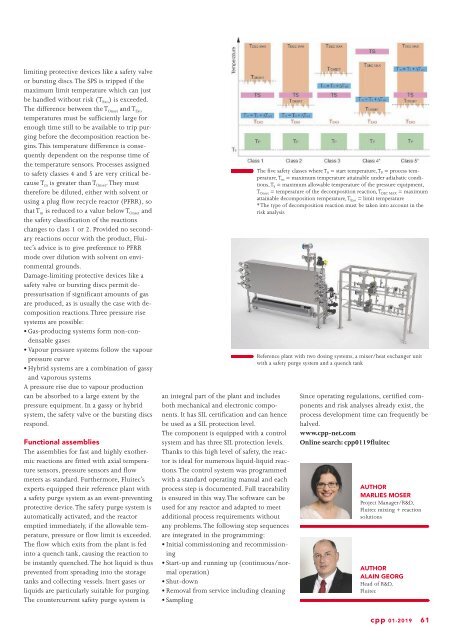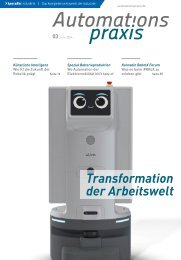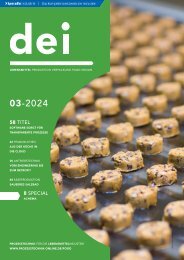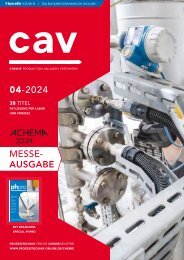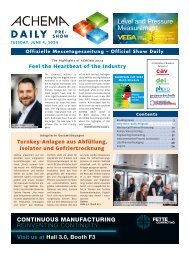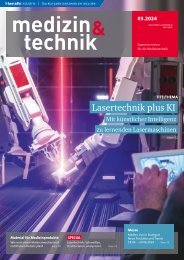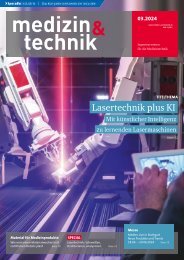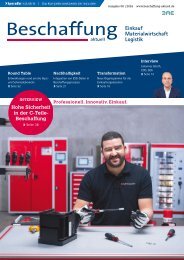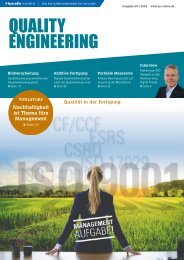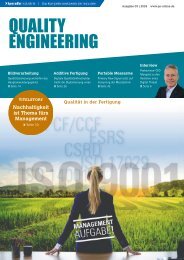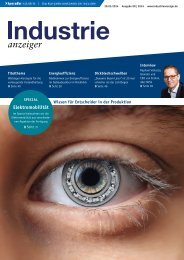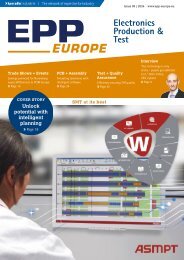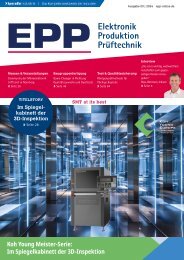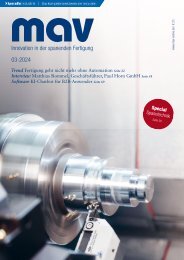cpp – Process technology for the chemical industry 01.2019
The journal cpp - Process technology for the chemical industry reports about processes, plants, apparatus and components for the chemical and pharmaceutical industry. Further topics are IT technologies, industry 4.0, digital production, MSR and automation technology and process analysis technology. The content spectrum is rounded off by explosion protection, plant safety, occupational health and safety, maintenance, site management and energy management.
The journal cpp - Process technology for the chemical industry reports about processes, plants, apparatus and components for the chemical and pharmaceutical industry. Further topics are IT technologies, industry 4.0, digital production, MSR and automation technology and process analysis technology. The content spectrum is rounded off by explosion protection, plant safety, occupational health and safety, maintenance, site management and energy management.
You also want an ePaper? Increase the reach of your titles
YUMPU automatically turns print PDFs into web optimized ePapers that Google loves.
limiting protective devices like a safety valve<br />
or bursting discs. The SPS is tripped if <strong>the</strong><br />
maximum limit temperature which can just<br />
be handled without risk (T Exo ) is exceeded.<br />
The difference between <strong>the</strong> T Onset and T Exo<br />
temperatures must be sufficiently large <strong>for</strong><br />
enough time still to be available to trip purging<br />
be<strong>for</strong>e <strong>the</strong> decomposition reaction begins.<br />
This temperature difference is consequently<br />
dependent on <strong>the</strong> response time of<br />
<strong>the</strong> temperature sensors. <strong>Process</strong>es assigned<br />
to safety classes 4 and 5 are very critical because<br />
T m is greater than T Onset . They must<br />
<strong>the</strong>re<strong>for</strong>e be diluted, ei<strong>the</strong>r with solvent or<br />
using a plug flow recycle reactor (PFRR), so<br />
that T m is reduced to a value below T Onset and<br />
<strong>the</strong> safety classification of <strong>the</strong> reactions<br />
changes to class 1 or 2. Provided no secondary<br />
reactions occur with <strong>the</strong> product, Fluitec’s<br />
advice is to give preference to PFRR<br />
mode over dilution with solvent on environmental<br />
grounds.<br />
Damage-limiting protective devices like a<br />
safety valve or bursting discs permit depressurisation<br />
if significant amounts of gas<br />
are produced, as is usually <strong>the</strong> case with decomposition<br />
reactions. Three pressure rise<br />
systems are possible:<br />
• Gas-producing systems <strong>for</strong>m non-condensable<br />
gases<br />
• Vapour pressure systems follow <strong>the</strong> vapour<br />
pressure curve<br />
• Hybrid systems are a combination of gassy<br />
and vaporous systems<br />
A pressure rise due to vapour production<br />
can be absorbed to a large extent by <strong>the</strong><br />
pressure equipment. In a gassy or hybrid<br />
system, <strong>the</strong> safety valve or <strong>the</strong> bursting discs<br />
respond.<br />
Functional assemblies<br />
The assemblies <strong>for</strong> fast and highly exo<strong>the</strong>rmic<br />
reactions are fitted with axial temperature<br />
sensors, pressure sensors and flow<br />
meters as standard. Fur<strong>the</strong>rmore, Fluitec’s<br />
experts equipped <strong>the</strong>ir reference plant with<br />
a safety purge system as an event-preventing<br />
protective device. The safety purge system is<br />
automatically activated, and <strong>the</strong> reactor<br />
emptied immediately, if <strong>the</strong> allowable temperature,<br />
pressure or flow limit is exceeded.<br />
The flow which exits from <strong>the</strong> plant is fed<br />
into a quench tank, causing <strong>the</strong> reaction to<br />
be instantly quenched. The hot liquid is thus<br />
prevented from spreading into <strong>the</strong> storage<br />
tanks and collecting vessels. Inert gases or<br />
liquids are particularly suitable <strong>for</strong> purging.<br />
The countercurrent safety purge system is<br />
an integral part of <strong>the</strong> plant and includes<br />
both mechanical and electronic components.<br />
It has SIL certification and can hence<br />
be used as a SIL protection level.<br />
The component is equipped with a control<br />
system and has three SIL protection levels.<br />
Thanks to this high level of safety, <strong>the</strong> reactor<br />
is ideal <strong>for</strong> numerous liquid-liquid reactions.<br />
The control system was programmed<br />
with a standard operating manual and each<br />
process step is documented. Full traceability<br />
is ensured in this way. The software can be<br />
used <strong>for</strong> any reactor and adapted to meet<br />
additional process requirements without<br />
any problems. The following step sequences<br />
are integrated in <strong>the</strong> programming:<br />
• Initial commissioning and recommissioning<br />
• Start-up and running up (continuous/normal<br />
operation)<br />
• Shut-down<br />
• Removal from service including cleaning<br />
• Sampling<br />
The five safety classes where T 0 = start temperature, T P = process temperature,<br />
T m = maximum temperature attainable under adiabatic conditions,<br />
T S = maximum allowable temperature of <strong>the</strong> pressure equipment,<br />
T Onset = temperature of <strong>the</strong> decomposition reaction, T DEC MAX = maximum<br />
attainable decomposition temperature, T Exo = limit temperature<br />
* The type of decomposition reaction must be taken into account in <strong>the</strong><br />
risk analysis<br />
Reference plant with two dosing systems, a mixer/heat exchanger unit<br />
with a safety purge system and a quench tank<br />
Since operating regulations, certified components<br />
and risk analyses already exist, <strong>the</strong><br />
process development time can frequently be<br />
halved.<br />
www.<strong>cpp</strong>-net.com<br />
Online search: <strong>cpp</strong>0119fluitec<br />
AUTHOR:<br />
MARLIES MOSER<br />
Project Manager/R&D,<br />
Fluitec mixing + reaction<br />
solutions<br />
AUTHOR:<br />
ALAIN GEORG<br />
Head of R&D,<br />
Fluitec<br />
<strong>cpp</strong> 01-2019 61


